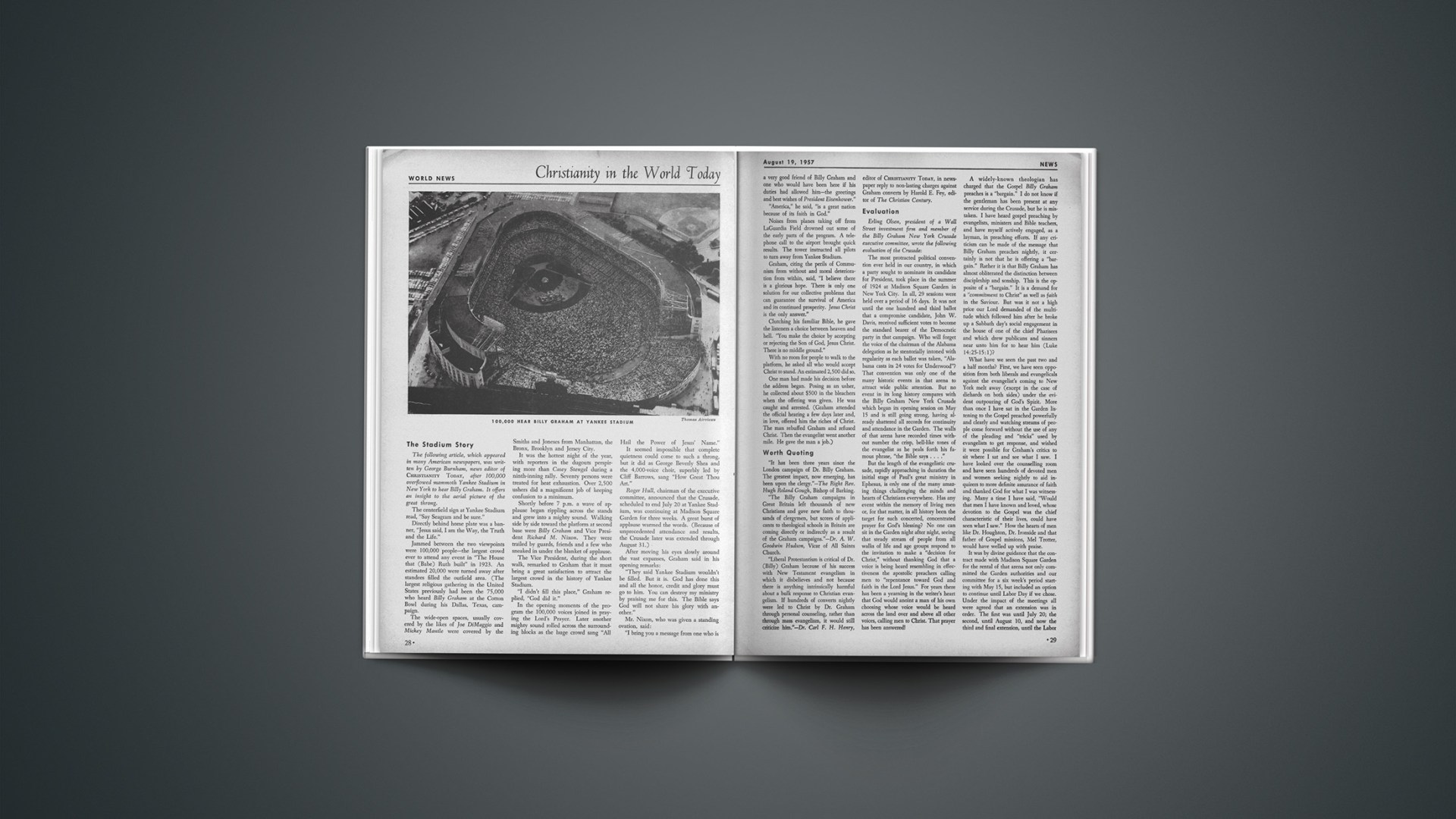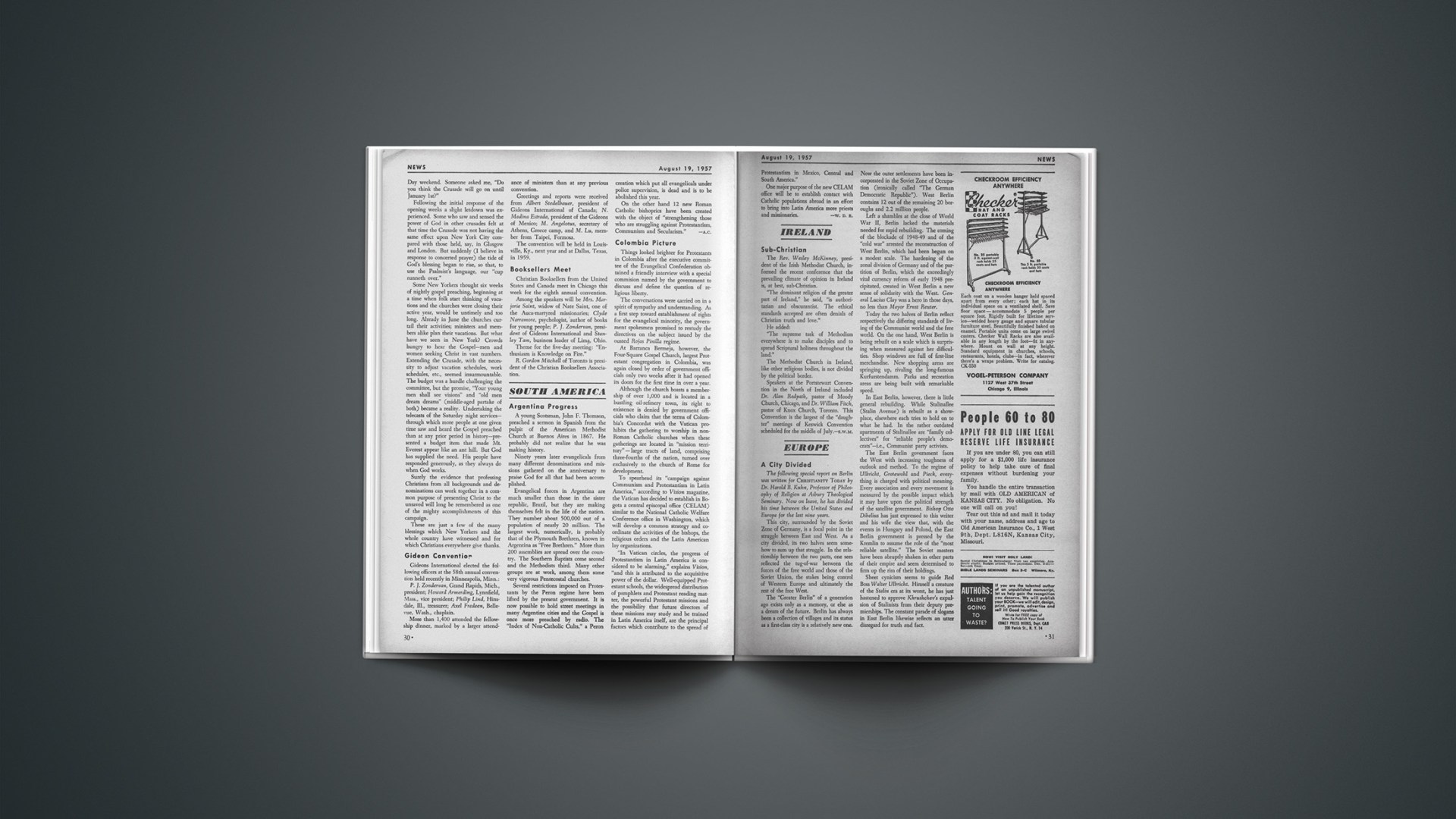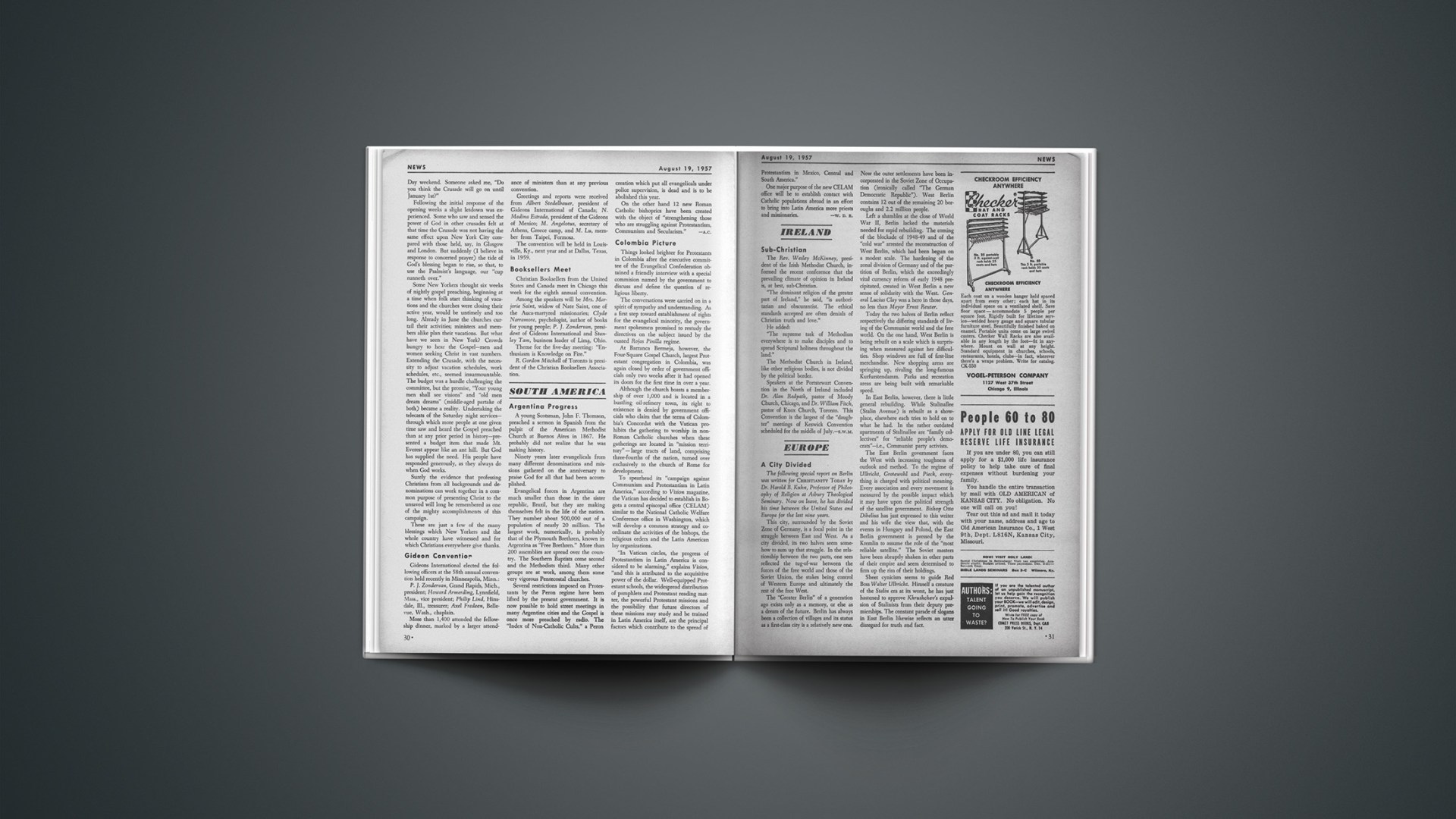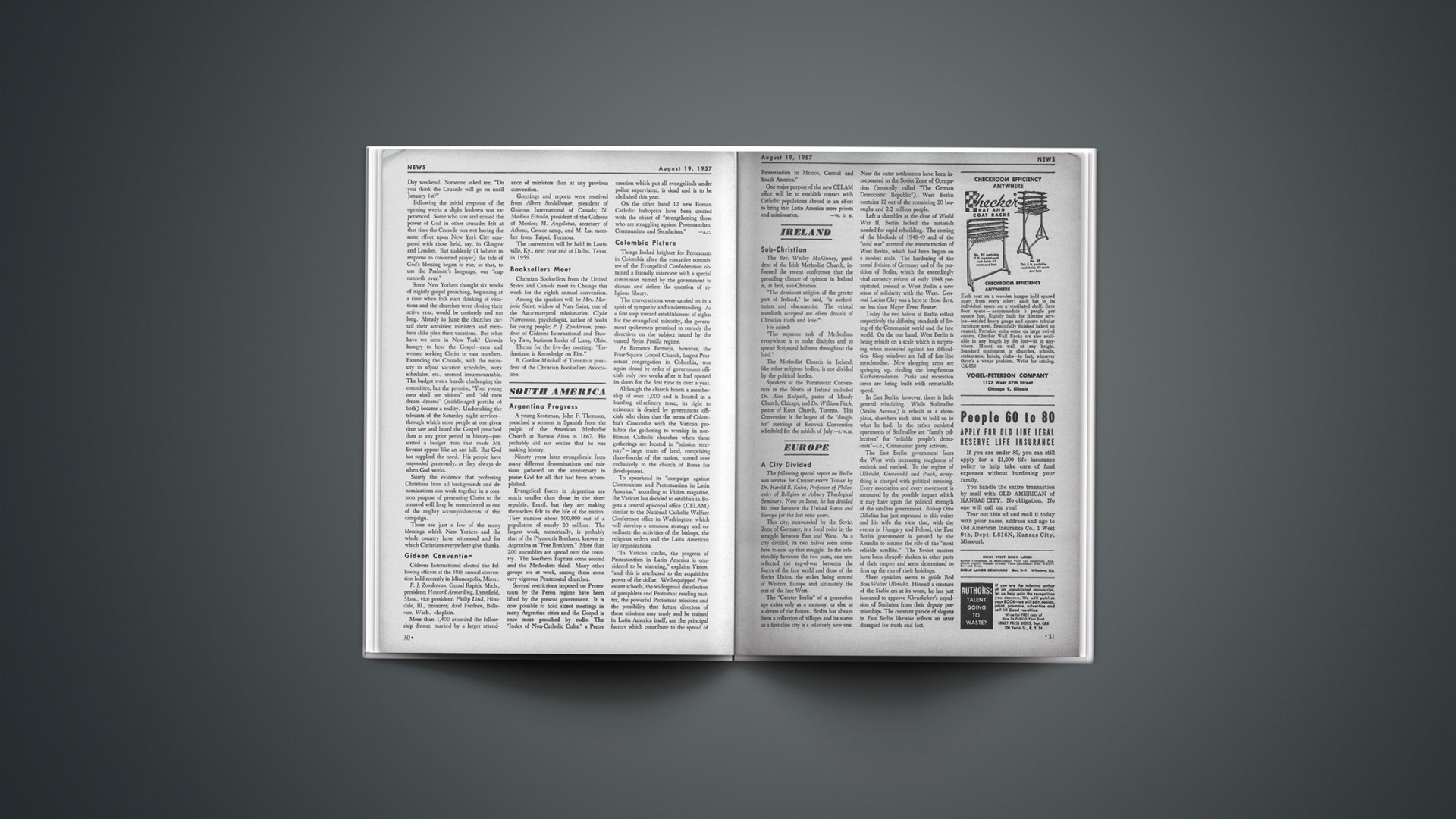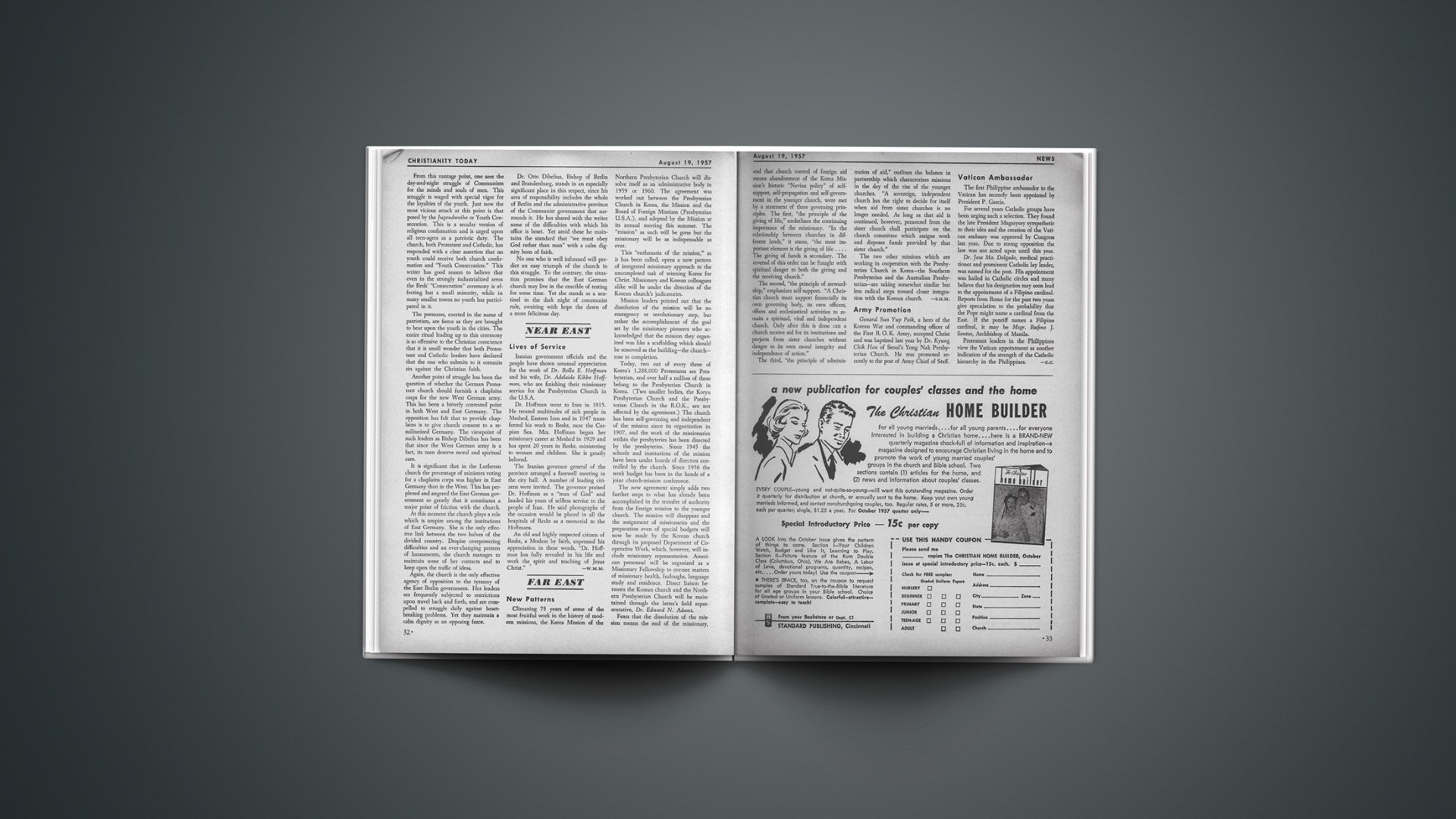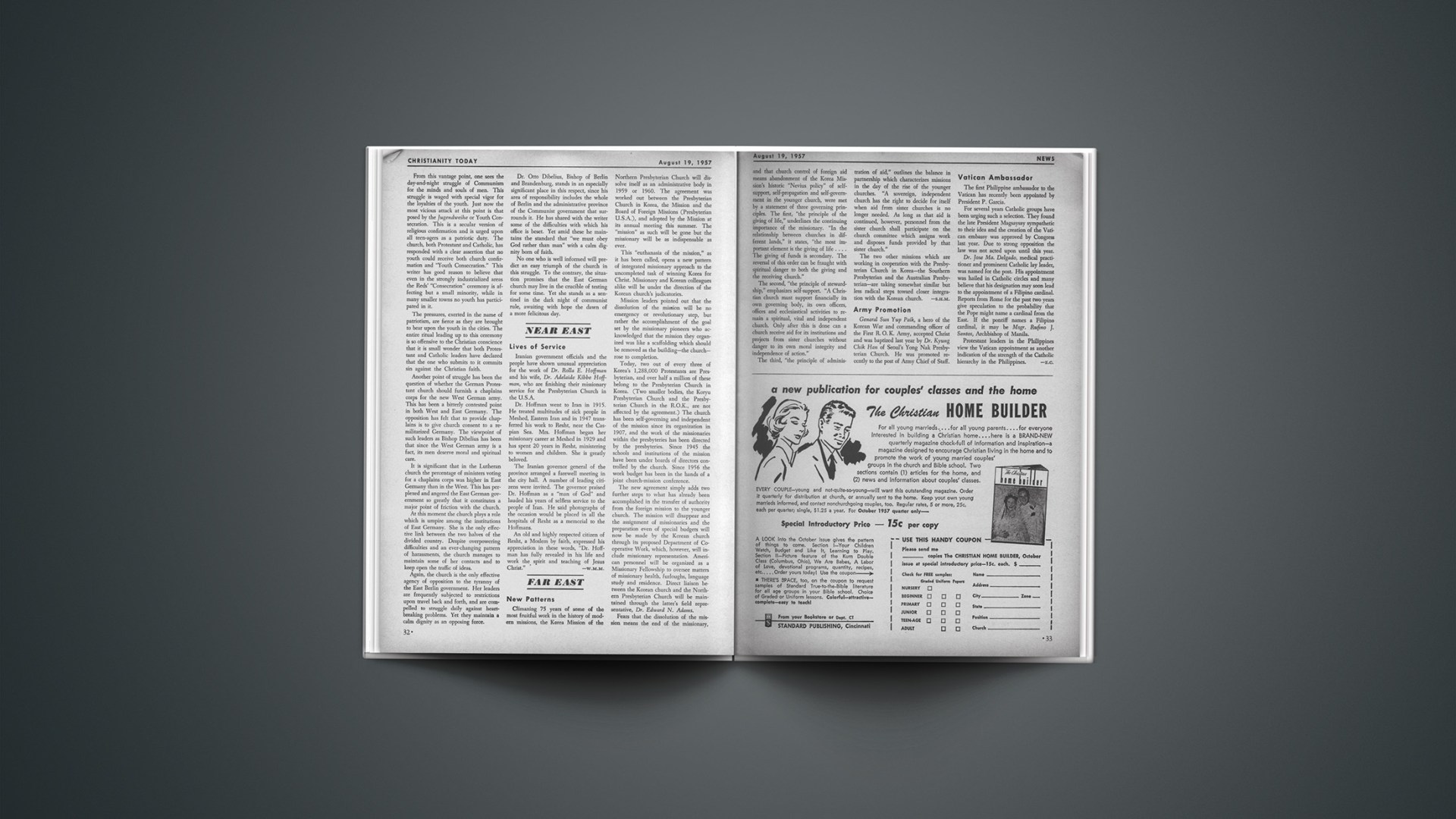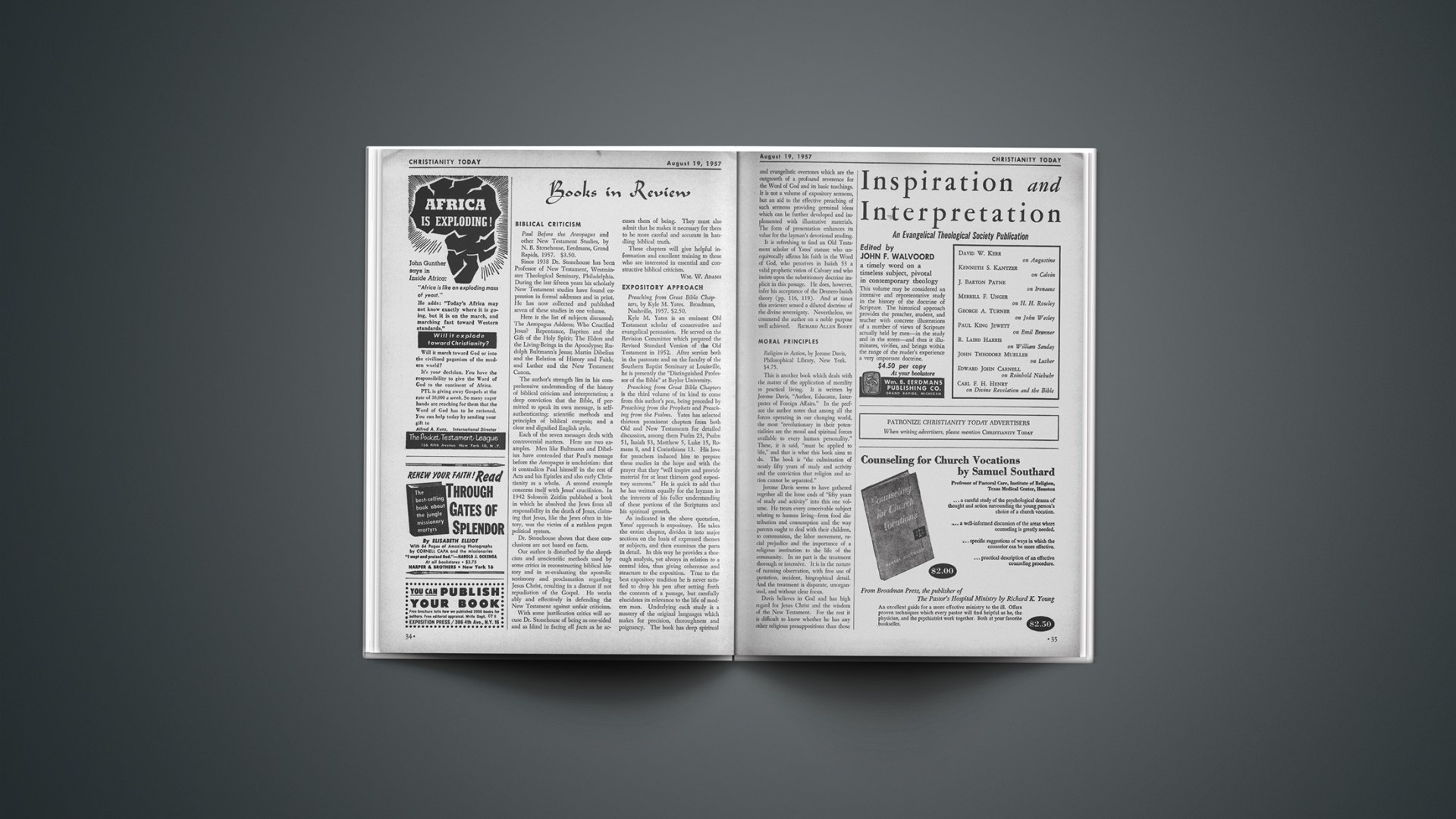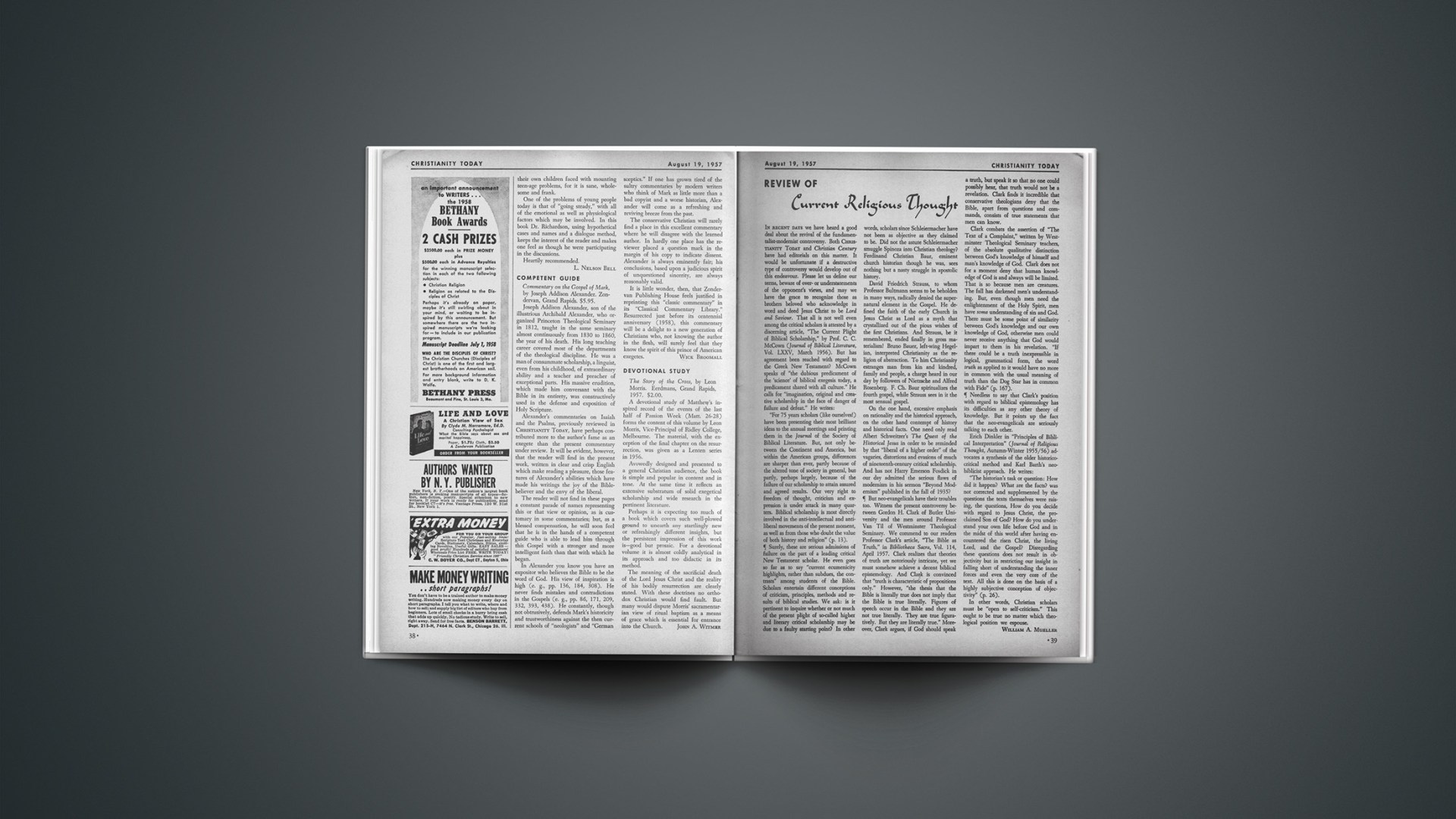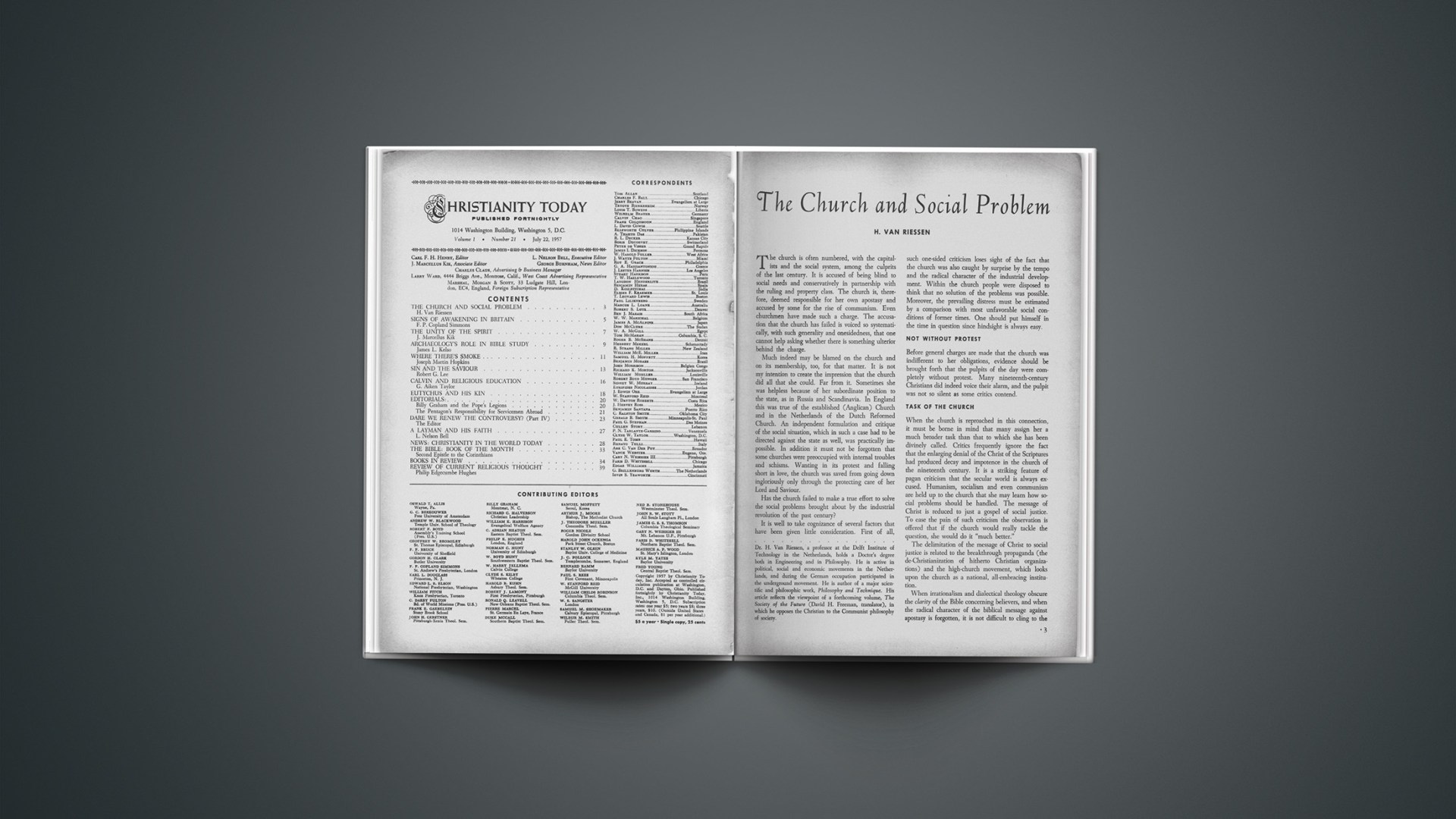WORLD NEWS
Christianity in the World Today
The following article, which appeared in many American newspapers, was written by George Burnham, news editor ofCHRISTIANITY TODAY, after 100,000 overflowed mammoth Yankee Stadium in New York to hear Billy Graham. It offers an insight to the aerial picture of the great throng.
The centerfield sign at Yankee Stadium read, “Say Seagram and be sure.”
Directly behind home plate was a banner, “Jesus said, I am the Way, the Truth and the Life.”
Jammed between the two viewpoints were 100,000 people—the largest crowd ever to attend any event in “The House that (Babe) Ruth built” in 1923. An estimated 20,000 were turned away after standees filled the outfield area. (The largest religious gathering in the United States previously had been the 75,000 who heard Billy Graham at the Cotton Bowl during his Dallas. Texas, campaign.
The wide-open spaces, usually covered by the likes of Joe DiMaggio and Mickey Mantle were covered by the Smiths and Joneses from Manhattan, the Bronx, Brooklyn and Jersey City.
It was the hottest night of the year, with reporters in the dugouts perspiring more than Casey Stengel during a ninth-inning rally. Seventy persons were treated for heat exhaustion. Over 2,500 ushers did a magnificent job of keeping confusion to a minimum.
Shortly before 7 p.m. a wave of applause began rippling across the stands and grew into a mighty sound. Walking side by side toward the platform at second base were Billy Graham and Vice President Richard M. Nixon. They were trailed by guards, friends and a few who sneaked in under the blanket of applause.
The Vice President, during the short walk, remarked to Graham that it must bring a great satisfaction to attract the largest crowd in the history of Yankee Stadium.
“I didn’t fill this place,” Graham replied, “God did it.”
In the opening moments of the program the 100,000 voices joined in praying the Lord’s Prayer. Later another mighty sound rolled across the surrounding blocks as the huge crowd sang “All Hail the Power of Jesus’ Name.”
It seemed impossible that complete quietness could come to such a throng, but it did as George Beverly Shea and the 4,000-voice choir, superbly led by Cliff Barrows, sang “How Great Thou Art.”
Roger Hull, chairman of the executive committee, announced that the Crusade, scheduled to end July 20 at Yankee Stadium, was continuing at Madison Square Garden for three weeks. A great burst of applause warmed the words. (Because of unprecedented attendance and results, the Crusade later was extended through August 31.)
After moving his eyes slowly around the vast expanses, Graham said in his opening remarks:
“They said Yankee Stadium wouldn’t be filled. But it is. God has done this and all the honor, credit and glory must go to him. You can destroy my ministry by praising me for this. The Bible says God will not share his glory with another.”
Mr. Nixon, who was given a standing ovation, said:
“I bring you a message from one who is a very good friend of Billy Graham and one who would have been here if his duties had allowed him—the greetings and best wishes of President Eisenhower.”
“America,” he said, “is a great nation because of its faith in God.”
Noises from planes taking off from LaGuardia Field drowned out some of the early parts of the program. A telephone call to the airport brought quick results. The tower instructed all pilots to turn away from Yankee Stadium.
Graham, citing the perils of Communism from without and moral deterioration from within, said, “I believe there is a glorious hope. There is only one solution for our collective problems that can guarantee the survival of America and its continued prosperity. Jesus Christ is the only answer.”
Clutching his familiar Bible, he gave the listeners a choice between heaven and hell. “You make the choice by accepting or rejecting the Son of God, Jesus Christ. There is no middle ground.”
With no room for people to walk to the platform, he asked all who would accept Christ to stand. An estimated 2,500 did so.
One man had made his decision before the address began. Posing as an usher, he collected about $500 in the bleachers when the offering was given. He was caught and arrested. (Graham attended the official hearing a few days later and, in love, offered him the riches of Christ. The man rebuffed Graham and refused Christ. Then the evangelist went another mile. He gave the man a job.)
Worth Quoting
“It has been three years since the London campaign of Dr. Billy Graham. The greatest impact, now emerging, has been upon the clergy.”—The Right Rev. Hugh Roland Gough, Bishop of Barking.
“The Billy Graham campaigns in Great Britain left thousands of new Christians and gave new faith to thousands of clergymen, but scores of applicants to theological schools in Britain are coming directly or indirectly as a result of the Graham campaigns.”—Dr. A. W. Goodwin Hudson, Vicar of All Saints Church.
“Liberal Protestantism is critical of Dr. (Billy) Graham because of his success with New Testament evangelism in which it disbelieves and not because there is anything intrinsically harmful about a bulk response to Christian evangelism. If hundreds of converts nightly were led to Christ by Dr. Graham through personal counseling, rather than through mass evangelism, it would still criticize him.”—Dr. Carl F. H. Henry, editor of CHRISTIANITY TODAY, in newspaper reply to non-lasting charges against Graham converts by Harold E. Fey, editor of The Christian Century.
Evaluation
Erling Olsen, president of a Wall Street investment firm and member of the Billy Graham New York Crusade executive committee, wrote the following evaluation of the Crusade:
The most protracted political convention ever held in our country, in which a party sought to nominate its candidate for President, took place in the summer of 1924 at Madison Square Garden in New York City. In all, 29 sessions were held over a period of 16 days. It was not until the one hundred and third ballot that a compromise candidate, John W. Davis, received sufficient votes to become the standard bearer of the Democratic party in that campaign. Who will forget the voice of the chairman of the Alabama delegation as he stentorially intoned with regularity as each ballot was taken, “Alabama casts its 24 votes for Underwood”? That convention was only one of the many historic events in that arena to attract wide public attention. But no event in its long history compares with the Billy Graham New York Crusade which began its opening session on May 15 and is still going strong, having already shattered all records for continuity and attendance in the Garden. The walls of that arena have recorded times without number the crisp, bell-like tones of the evangelist as he peals forth his famous phrase, “the Bible says.…”
But the length of the evangelistic crusade, rapidly approaching in duration the initial stage of Paul’s great ministry in Ephesus, is only one of the many amazing things challenging the minds and hearts of Christians everywhere. Has any event within the memory of living men or, for that matter, in all history been the target for such concerted, concentrated prayer for God’s blessing? No one can sit in the Garden night after night, seeing that steady stream of people from all walks of life and age groups respond to the invitation to make a “decision for Christ,” without thanking God that a voice is being heard resembling in effectiveness the apostolic preachers calling men to “repentance toward God and faith in the Lord Jesus.” For years there has been a yearning in the writer’s heart that God would anoint a man of his own choosing whose voice would be heard across the land over and above all other voices, calling men to Christ. That prayer has been answered!
A widely-known theologian has charged that the Gospel Billy Graham preaches is a “bargain.” I do not know if the gentleman has been present at any service during the Crusade, but he is mistaken. I have heard gospel preaching by evangelists, ministers and Bible teachers, and have myself actively engaged, as a layman, in preaching efforts. If any criticism can be made of the message that Billy Graham preaches nightly, it certainly is not that he is offering a “bargain.” Rather it is that Billy Graham has almost obliterated the distinction between discipleship and sonship. This is the opposite of a “bargain.” It is a demand for a “commitment to Christ” as well as faith in the Saviour. But was it not a high price our Lord demanded of the multitude which followed him after he broke up a Sabbath day’s social engagement in the house of one of the chief Pharisees and which drew publicans and sinners near unto him for to hear him (Luke 14:25–15:1)?
What have we seen the past two and a half months? First, we have seen opposition from both liberals and evangelicals against the evangelist’s coming to New York melt away (except in the case of diehards on both sides) under the evident outpouring of God’s Spirit. More than once I have sat in the Garden listening to the Gospel preached powerfully and clearly and watching streams of people come forward without the use of any of the pleading and “tricks” used by evangelists to get response, and wished it were possible for Graham’s critics to sit where I sat and see what I saw. I have looked over the counselling room and have seen hundreds of devoted men and women seeking nightly to aid inquirers to more definite assurance of faith and thanked God for what I was witnessing. Many a time I have said, “Would that men I have known and loved, whose devotion to the Gospel was the chief characteristic of their lives, could have seen what I saw.” How the hearts of men like Dr. Houghton, Dr. Ironside and that father of Gospel missions, Mel Trotter, would have welled up with praise.
It was by divine guidance that the contract made with Madison Square Garden for the rental of that arena not only committed the Garden authorities and our committee for a six week’s period starting with May 15, but included an option to continue until Labor Day if we chose. Under the impact of the meetings all were agreed that an extension was in order. The first was until July 20; the second, until August 10, and now the third and final extension, until the Labor Day weekend. Someone asked me, “Do you think the Crusade will go on until January 1st?”
Following the initial response of the opening weeks a slight letdown was experienced. Some who saw and sensed the power of God in other crusades felt at that time the Crusade was not having the same effect upon New York City compared with those held, say, in Glasgow and London. But suddenly (I believe in response to concerted prayer) the tide of God’s blessing began to rise, so that, to use the Psalmist’s language, our “cup runneth over.”
Some New Yorkers thought six weeks of nightly gospel preaching, beginning at a time when folk start thinking of vacations and the churches were closing their active year, would be untimely and too long. Already in June the churches curtail their activities; ministers and members alike plan their vacations. But what have we seen in New York? Crowds hungry to hear the Gospel—men and women seeking Christ in vast numbers. Extending the Crusade, with the necessity to adjust vacation schedules, work schedules, etc., seemed insurmountable. The budget was a hurdle challenging the committee, but the promise, “Your young men shall see visions” and “old men dream dreams” (middle-aged partake of both) became a reality. Undertaking the telecasts of the Saturday night services—through which more people at one given time saw and heard the Gospel preached than at any prior period in history—presented a budget item that made Mt. Everest appear like an ant hill. But God has supplied the need. His people have responded generously, as they always do when God works.
Surely the evidence that professing Christians from all backgrounds and denominations can work together in a common purpose of presenting Christ to the unsaved will long be remembered as one of the mighty accomplishments of this campaign.
These are just a few of the many blessings which New Yorkers and the whole country have witnessed and for which Christians everywhere give thanks.
Gideon Convention
Gideons International elected the following officers at the 58th annual convention held recently in Minneapolis, Minn.:
P. J. Zondervan, Grand Rapids, Mich., president; Howard Armerding, Lynnfield, Mass., vice president; Philip Lind, Hinsdale, Ill., treasurer; AxelFredeen, Bellevue, Wash., chaplain.
More than 1,400 attended the fellowship dinner, marked by a larger attendance of ministers than at any previous convention.
Greetings and reports were received from Albert Stedelbauer, president of Gideons International of Canada; N. Medina Estrada, president of the Gideons of Mexico; M. Angelotus, secretary of Athens, Greece camp, and M. Lu, member from Taipei, Formosa.
The convention will be held in Louisville, Ky., next year and at Dallas, Texas, in 1959.
Booksellers Meet
Christian Booksellers from the United States and Canada meet in Chicago this week for the eighth annual convention.
Among the speakers will be Mrs. Marjorie Saint, widow of Nate Saint, one of the Auca-martyred missionaries; Clyde Narramore, psychologist, author of books for young people; P. J. Zondervan, president of Gideons International and Stanley Tam, business leader of Lima, Ohio.
Theme for the five-day meeting: “Enthusiasm is Knowledge on Fire.”
R. Gordon Mitchell of Toronto is president of the Christian Booksellers Association.

